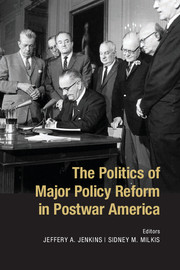Book contents
- Frontmatter
- Contents
- Contributors
- Acknowledgments
- 1 Introduction
- 2 The Long 1950s as a Policy Era
- 3 Regulation, Litigation, and Reform
- 4 Courts and Agencies in the American Civil Rights State
- 5 The Politics of Labor Policy Reform
- 6 Teachers Unions and American Education Reform
- 7 Progressive Federalism and the Contested Implementation of Obama’s Health Reform
- 8 Federalism and the Politics of Immigration Reform
- 9 Trade Politics and Reform
- 10 The Politics of Intelligence Reform
- 11 Follow the Leader
- 12 Conclusion: Madison Upside Down
- Index
- References
2 - The Long 1950s as a Policy Era
Published online by Cambridge University Press: 05 November 2014
- Frontmatter
- Contents
- Contributors
- Acknowledgments
- 1 Introduction
- 2 The Long 1950s as a Policy Era
- 3 Regulation, Litigation, and Reform
- 4 Courts and Agencies in the American Civil Rights State
- 5 The Politics of Labor Policy Reform
- 6 Teachers Unions and American Education Reform
- 7 Progressive Federalism and the Contested Implementation of Obama’s Health Reform
- 8 Federalism and the Politics of Immigration Reform
- 9 Trade Politics and Reform
- 10 The Politics of Intelligence Reform
- 11 Follow the Leader
- 12 Conclusion: Madison Upside Down
- Index
- References
Summary
If policy reform amounts to nonincremental change, what can we say about postwar America before the mid-1960s? Those early years are often dismissed as the doldrums and as a time of Deadlock of Democracy. I argue here that this judgment is quite wrong.
Discernible in those days is a policy era, with its own kind of content and integrity. By the term “policy era” I do not mean anything fancy. I mean a time span of policy enterprises, all involving congressional action, that can be apprehended using reasonable empirical care, that share an animation and direction, and that amount to a major cumulative policy record. For political context, think of Frank D. Baumgartner and Bryan D. Jones’s “waves of enthusiasm” or John W. Kingdon’s “national moods” that can pry open “policy windows.”
I use a particular empirical wedge in my discussion. I am wary of labels like the New Deal, the Fair Deal, and the New Frontier as guides to policy eras. Politicians promote such labels for their own purposes, and they coast into usages that are both ideologically freighted and gauzy. They can become impediments to understanding. They can dominate and obscure the contents of their presumed packages.3 Possibly better is a nominalistic course of examining actual policy moves one by one, leaving aside any assumptions about lumping or labels, to see what they are and what they add up to. A good instance is the sequence of new regulatory legislation from the mid-1960s through the mid-1970s. That went from the Traffic Safety Act of 1966 through the Truth in Lending Act of 1968, theClean AirAct of 1970, the Occupational Safety and Health Act of 1970, the Water Pollution Control Act of 1972, the Consumer Product Safety Act of 1972, the Endangered Species Act of 1973, the Federal Election Campaign Act of 1974, and the Toxic Substances Control Act of 1976. This is far from an exhaustive list. For a decade, the beat went on. At issue is pattern recognition. Through a one-by-one identification of items – not through an overarching label such as “the Great Society” – we can see a major policy era centering on increases in government regulation.
- Type
- Chapter
- Information
- The Politics of Major Policy Reform in Postwar America , pp. 27 - 47Publisher: Cambridge University PressPrint publication year: 2014



